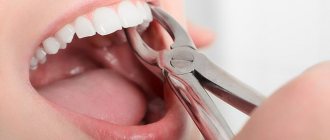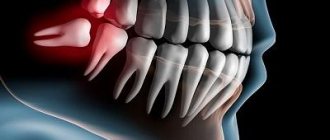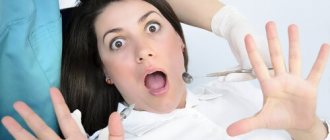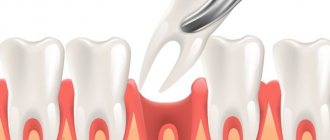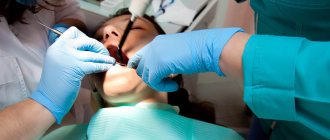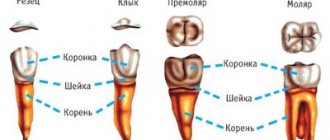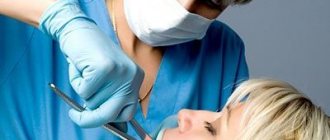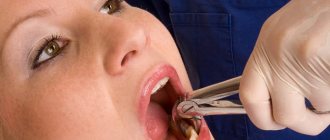A 60-year-old patient came to the Research Center clinic with a complaint that she had mobility of the front tooth of the central incisor. Purulent discharge appeared from the gums in the area of the front teeth from the fistulous tract. From her story it became clear that the patient had previously had metal-free structures installed, crowns on her front teeth, the so-called. central incisors. She had them done in another clinic, where before installing crowns she had intra-canal teeth whitening
, which may have triggered a number of pathological processes.
The decision was made based on the CT scan:
- remove 2 central incisors, remove two upper front teeth
- and install implants with immediate loading.
Immediate loading
means that prosthetics of the upper anterior teeth will be performed on our patient also on the day of surgery.
It was also decided for the patient to leave and use as temporary crowns the veneers of those crowns that she had on her front teeth at the time of her visit to our clinic.
Therefore, the teeth, two central incisors, were removed very carefully. The photograph clearly shows that both incisors have a lesion
: the root part of the teeth was destroyed, eaten away, and these teeth could not be saved.
The anterior teeth were removed atraumatically,
with preservation of holes. And - with the preservation of the old crowns as temporary prostheses for the upper front teeth, which were useful to us for securing them to the installed implants in the future.
In this photo you can see the sockets of the teeth
. I can note that the removal of the upper front teeth was atraumatic, but in the area of tooth 11 (the first incisor of the first segment), due to a fistulous tract on the gum, severe destruction of the root occurred, as a result of which the cortical plate was lost. When such a fistulous tract occurs in the area of the front teeth, it means that the process has already started, a lot of unpleasant things have already happened. In this case, the cortical plate was destroyed. Before the removal of the front teeth, at the planning stage, individual templates were made for the patient, with the help of which the implants were subsequently installed.
What instruments are used to remove teeth?
Dental forceps have been and remain tools for removing teeth. For certain groups of teeth, a different type of forceps is used, since our teeth have different structures and are located differently in the dentition. For example, to remove the upper anterior tooth and the maxillary canine, there are straight forceps, and the remaining upper teeth are removed using S-shaped ones. The incisors of the lower jaw are pulled out using forceps curved at 90º with narrow cheeks (the part of the forceps that grasps the crown or root of the tooth being removed). The fangs and the two teeth following them are pulled with forceps, on the contrary, with wide cheeks. To remove large molars of the lower jaw, forceps with spikes that go between the roots are used.
What teeth are removed in the lower jaw?
Depending on the type of teeth, extraction occurs with varying degrees of complexity. Single-rooted front incisors are easier to remove (2 pieces on each side). The canines (on either side of the incisors) have a chisel-shaped root hidden deep in the gum. Sometimes it becomes bent or bifurcated. Together with the incisors, the canines are involved in biting.
The lateral teeth that perform the chewing function include 2 small molars with one root, and 2 large ones with two even roots.
In the eighth position are wisdom teeth. Extraction is complicated by irregular growth and long, twisted roots, the number of which sometimes reaches up to five. These organs do not bear any functional load. Extraction of figure eights is difficult, and sometimes anesthesia is used.
Tooth extraction is practiced if they have an unaesthetic appearance, are a source of infection in the periodontium and cannot be treated, or the crown of the organ is completely destroyed. Extraction is used for growth pathologies, the formation of cysts and abscesses, and to correct bites.
Stages of the procedure
Teeth extraction in St. Petersburg is performed using the latest technologies, using modern instruments. The extraction takes place without pain or complications - effective medications are used for this.
Extraction begins 5-7 minutes after the administration of the anesthetic. The surgeon peels off the gum and uses forceps with wide cheeks to grab the tooth and then remove it. In simple cases, this takes no more than 1 minute. But sometimes it is pulled out in parts.
Complications
Complications sometimes occur during tooth extraction. The first is bleeding. Normally, it stops as soon as a blood clot forms in the socket (this takes up to 30 minutes). But sometimes gum bleeding begins hours later and even the next day. Provoking factors are the following:
- vasodilation after the anesthetic wears off;
- damage to blood vessels, soft or bone tissue, large arteries (rare);
- infection in the socket;
- other reasons caused by the characteristics of the patient’s body.
The next complication is the already mentioned infection (alveolitis), which causes pain and destruction of the walls of the socket, an abscess. If swelling or pain occurs, the patient should consult a doctor. Sometimes there is damage to the nerve endings, which causes loss of sensitivity. After extraction of lower molars, swelling often occurs, making it difficult to speak and eat.
Price
Prices for tooth extractions in St. Petersburg depend on the complexity of the procedure and range from 3000-7500 rubles. The minimum cost of anesthesia is 8 thousand rubles. in 1 hour. Due to the dense bone tissue in the lower jaw, more anesthesia is required, which also affects the price.
The MY ORT clinic employs highly qualified medical personnel who can solve almost any of your dental problems. Call us at our number and make an appointment. The first visit to the dentist is absolutely free!
What is the typical tooth extraction process like?
When teeth are removed, local anesthesia is first administered. The doctor then removes about half a centimeter of gum tissue from the tooth. Then forceps are applied to the crown of the tooth being removed. When removing teeth in the upper jaw, the doctor presses on the forceps with his entire right hand. When removing teeth on the lower jaw, pressure is applied with the thumb of the right hand. The tooth is then dislocated to destroy the tissue that holds it in place. To remove single-rooted teeth, such as front teeth, rotational or pendulum-like movements are performed. When removing molars, pendulum-like movements are performed. The culmination of this action is the tooth extracted from the hole.
Changes in soft tissues
Attached soft tissues also change when bone volume changes. The gums shrink in volume and become thinner. In the lower jaw, the layer of attached soft tissue may be very thin or almost absent.
Periodontal nutrition is disrupted and blood supply deteriorates. This further accelerates destruction: surface tissues become thin, susceptible to inflammation and irritation. In advanced cases, bedsores form. Destructive processes provoke the development of chronic periodontal diseases. These, in turn, can lead to the loss of adjacent teeth.
If toothless ridges of bone tissue on the jaw have already formed, the tongue can gradually increase in size: it fills the space that was previously occupied. With the loss of one tooth, such manifestations are minimal; if there are several gaps in the dentition, the enlargement of the tongue will be clearly visible.
How is a complex tooth extraction performed?
Complex wisdom tooth extraction is considered to be a case when the tooth cannot be removed with the simple application of forceps. As a rule, in such situations, access to the root of the tooth being removed is first created by cutting the mucous membrane and periosteum. Complex tooth extraction with an oblique or horizontal position is carried out in parts, for which a laser or a special saw is often used. You should not be afraid of this, since cutting a hard-to-reach tooth only shortens the time of its removal. After the procedure, the doctor smoothes the sharp edges of the bone wound, washes it with hydrogen peroxide or furatsilin, the mucoperiosteal flap is placed in place and fixed with sutures.
In complex cases, tooth extraction surgery does not have a uniform technique. How the doctor will act depends on the specific case.
After tooth extraction: a reminder for the patient
1. Under no circumstances touch the wound formed after removal with your tongue or hands.
2. You will get rid of the discomfort caused by a cotton swab in your mouth within half an hour - after this time it can be removed.
3. Wait 2 hours before your first meal after visiting the doctor.
4. Avoid rough foods and hard vegetables and fruits until the wound heals.
5. After anesthesia, as a rule, thirst appears. Cold and hot liquid during the period after removal is strictly not recommended. Drink water at room temperature or lukewarm.
6. There is a great temptation to rinse your mouth and spit out the blood clots that have formed. Be patient, don’t do this on the first day - you will provoke bleeding and the healing period will be delayed.
7. Exposure to high temperatures promotes bleeding - exclude relaxation in a bathhouse or sauna from your plans for 3-4 days after the procedure.
8. Refrain from drinking alcohol and smoking for at least a day;
9. To avoid swelling, apply a small piece of ice to the wound for a couple of days (hold for 5 minutes, rest for 40 minutes).
10. Avoid physical activity for 3-4 days, try not to make sudden movements: bending, turning your head, etc.
11. If you experience severe pain after the anesthesia wears off, take a pain reliever - Ketanov, Nurofen, Nise or another drug recommended by the clinic.
When is complex tooth extraction indicated?
Tooth extraction is considered difficult due to tumor or edema, periodontitis, periodontitis, abscess and gumboil. The presence of a cyst and a fistulous tract in the tooth also complicates the removal procedure. Impacted (unerupted) teeth are also indications for surgical tooth extraction. Complex cases include the removal of a dystopic wisdom tooth located outside the dentition; removal of 4 teeth to correct malocclusion; removal of baby teeth in children at an early age. Severe curvature of the roots and fracture of the apical part of the root are also indications for surgery. Please note that complex tooth extraction is not performed during pregnancy.
The method in which your tooth will be removed depends on the individual case. Only a specialist can determine the removal strategy. In any case, you should not be afraid of this procedure. A competent doctor will perform the removal correctly, and all you have to do is say “thank you”
Painless tooth extraction
Our dental clinic employs highly qualified specialists with extensive practical experience. For surgical interventions, we use the most effective painkillers, which ensure that patients do not feel uncomfortable during the entire procedure. The clinic offers clients other benefits:
- individual selection of anesthesia;
- high level of hygiene;
- pediatric dentistry;
- extraction in difficult cases;
- affordable prices for the services offered.
Stages
Various techniques can be used to remove an upper tooth. The standard stages are:
- visual inspection, selection of tools;
- local anesthesia;
- detachment of the mucous membrane from the tooth, destruction of the upper periodontal junction;
- forceps are applied to the surface, advanced and fixed in a certain position;
- loosening and traction of the tooth is carried out;
- the remaining hole is inspected and, if necessary, treated with antiseptic agents;
- Then the hole is sutured or repositioned, and a tampon is applied to the wound.
Complications
If treatment or tooth extraction is not carried out, the following complications are likely:
- inflammation, soft tissue damage;
- damage to adjacent teeth, splitting of the crown, root;
- dysfunction of facial muscles;
- difficulty speaking and chewing food;
- fracture, dislocation of the jaw;
- bleeding.
The causes of such complications can be incorrectly selected instruments or violation of tooth extraction techniques. Complications can also arise if there is insufficient fixation of the jaw or failure to comply with the conditions for caring for the socket after removal.
To avoid complications, the following actions should not be performed after tooth extraction:
- take a hot bath, visit a sauna or bathhouse in the first couple of days;
- sleep on the side of the extracted tooth;
- engage in any physical activity;
- use aspirin to relieve pain;
- touch the wound, influence the hole in other ways;
- rinse your mouth for the first two to three days.
The gauze pad is removed from the wound after the bleeding has stopped; the doctor usually tells the patient when to do this. You cannot keep such a tampon for a long time, as it acts as a source of infection and can cause an inflammatory process. At first, ichor may be released in the wound area, but this is a natural process and should not be confused with bleeding. For the first two hours after the removal of the upper tooth, it is recommended to refrain from eating, but you can drink water. On the first day, it is also better to give up solid foods and replace them with soups and soft dishes. The first day you cannot smoke or drink alcohol.
You can eliminate swelling with an ice compress. It should be held in front of the sore spot for five minutes. Usually 4-5 times with a break of 10 minutes are enough.
In many cases, no special measures or pain medications are required. But in case of severe pain or inflammation, the doctor will recommend taking medications. The medication regimen must be strictly followed in order to achieve the desired effect and avoid complications. Additionally, you can make antiseptic baths.
Necessity of anesthesia
In modern medicine, local and general anesthesia are used. In the first case, the drug is injected into the gum tissue, and the patient remains conscious during the operation. General anesthesia is used much less frequently, due to the special restrictions and dangers of the procedure for the health of the body. This technique is recommended in the presence of the following factors:
- The need for simultaneous extraction of several units;
- The patient's inability to control the gag reflex;
- Severe phobia of dental procedures.
General anesthesia requires the involvement of a specialized specialist in the operation, which is why removing molars is more expensive.
Indications and contraindications
The factors that determine the removal of the upper front teeth include:
- Destruction of the unit, allowing access to pathogenic bacteria and allowing the possibility of infection of root canals and bone tissue;
- Fracture of the crown structure, accompanied by exposure of pulp tissue;
- Ineffectiveness of endodontic treatment of chronic periodontitis;
- Complete destruction of the tooth structure, in which the preserved root cannot be used as a basis for installing a prosthesis;
- Impacted position of the unit, leading to systematic tissue inflammation;
- Development of severe periodontal disease, causing tooth mobility;
- Mechanical injuries, including jaw fractures;
- Abnormal development of the dentition, including crowding of units.
The procedure may be temporarily or completely limited due to the following contraindications:
- Pathologies of the cardiovascular system;
- Acute forms of chronic diseases;
- Oncological diseases;
- Functional abnormalities of the central nervous system;
- Allergic reaction to anesthetic drugs;
- Diagnosed mental disorders.
The final decision on how exactly the removal of one or more teeth will be carried out is made by the dentist based on the results of a comprehensive examination.


